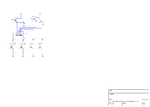Sailing_Nut
Newbie level 3
Hi all,
I am trying to work out a circuit to drive the windings of a stepper motor. I have done plenty of digging around and know the basics that I can use wither a FET or a Darlington pair to do the power switching. The problem that I am having is working out the power supply and matching it to the motor I have.
The motor I have is a 4V 1A bipolar stepper and I want to drive it with a +5V PC power supply. (Since I have it.) What I am trying to figure out is how to drop the voltage to 4V reliably for the motor. Will the drop across the junction of a Darlington pair be enough to do this? Or is that a bad design? Will a power resisitor in series with the winding and using a FET be a better solution?
Also, if there are any other considerations I need to make I'll take any information.
FYI, I plan on switching the transistors with either +5V or +3.3V logic levels.
Thanks in advance!
I am trying to work out a circuit to drive the windings of a stepper motor. I have done plenty of digging around and know the basics that I can use wither a FET or a Darlington pair to do the power switching. The problem that I am having is working out the power supply and matching it to the motor I have.
The motor I have is a 4V 1A bipolar stepper and I want to drive it with a +5V PC power supply. (Since I have it.) What I am trying to figure out is how to drop the voltage to 4V reliably for the motor. Will the drop across the junction of a Darlington pair be enough to do this? Or is that a bad design? Will a power resisitor in series with the winding and using a FET be a better solution?
Also, if there are any other considerations I need to make I'll take any information.
FYI, I plan on switching the transistors with either +5V or +3.3V logic levels.
Thanks in advance!
